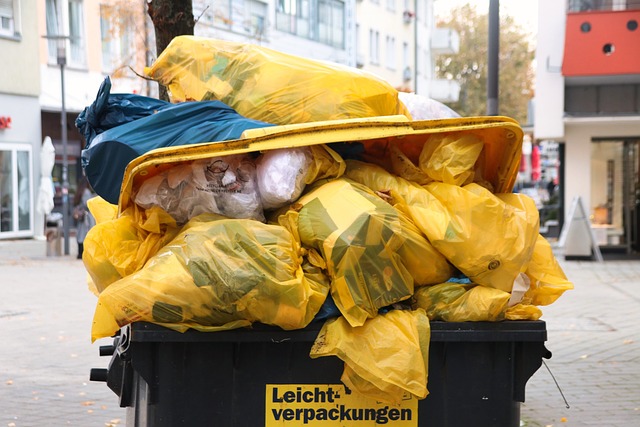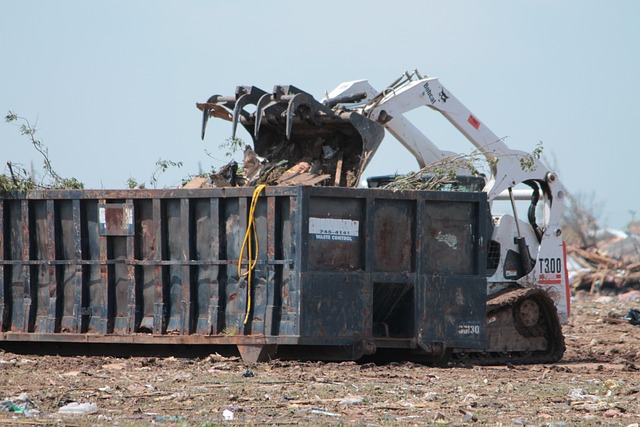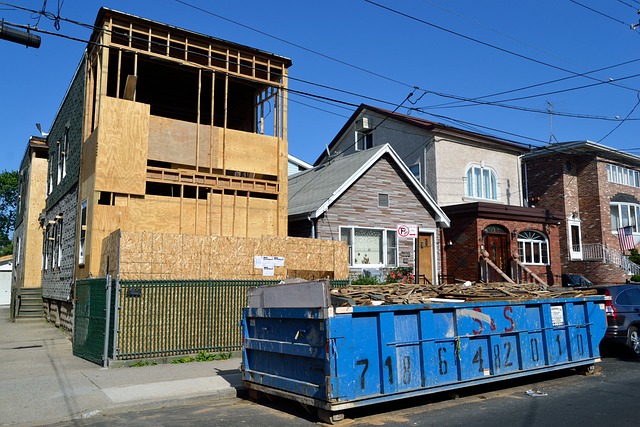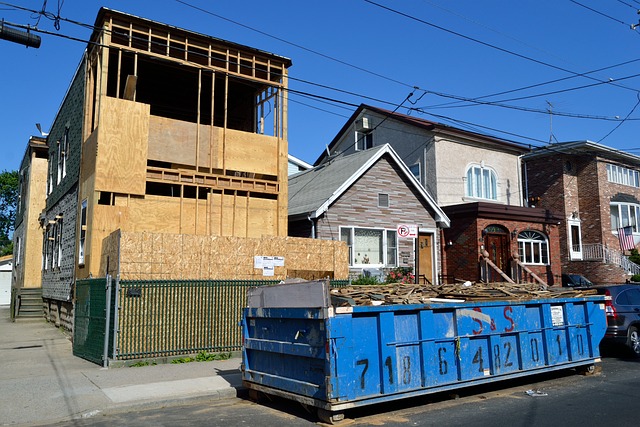The Queens Historic District Renovation project is a delicate endeavor that requires adherence to historical integrity and local preservation regulations. Any renovation must be sympathetic to the district's architectural and cultural significance, which is vital for maintaining New York's historical legacy. The selection of building materials is crucial, as they must align with the district's aesthetic and durability standards, ensuring compliance with preservation guidelines. Cleanup dumpsters play a pivotal role in this process by facilitating logistical efficiency, minimal disruption, and a tidy cleanup that respects the environment and the historic atmosphere. These dumpsters are strategically placed to support sustainability, community respect, and preservation goals within Queens Historic District. They offer responsible waste management solutions that comply with local regulations and preserve the district's charm and historical significance. The use of these specialized services is essential for handling renovation waste in a manner that ensures the enduring beauty and heritage of the Queens Historic District are preserved.
queens historic district renovation projects necessitate a delicate balance between modern functionality and preserving historical charm. This article explores the critical aspects of selecting building materials that honor the past while meeting contemporary needs. From legal and regulatory compliance to the practical role of cleanup dumpsters in facilitating waste management, each section delves into the nuances of historic renovation. Understanding the significance of these projects is paramount, as they not only maintain the integrity of Queens’ rich tapestry but also set a standard for future preservation efforts.
- Understanding the Significance of Queens Historic District Renovation
- Assessing the Scope and Requirements for Historic Renovation Projects
- The Role of Cleanup Dumpsters in Historic District Renovations
- Material Considerations for Preserving Historical Integrity
- Legal and Regulatory Compliance for Building Material Selection in Queens Historic District
- Strategies for Efficient Waste Management During Historic District Renovation Projects
Understanding the Significance of Queens Historic District Renovation

When embarking on a renovation project within the Queens Historic District, it is imperative to approach the endeavor with a deep respect for both the historical integrity and the local regulations governing such undertakings. The significance of this district lies not only in its architectural and cultural importance but also in its ability to preserve the legacy of New York’s rich past. Selecting appropriate building materials is a critical aspect of any renovation, especially within a historic context. These materials must align with the aesthetic and durability standards set forth by local preservation guidelines, ensuring that the renovation complements rather than detracts from the district’s character.
The Queens Historic District Renovation Cleanup Dumpsters play a pivotal role in the logistical management of the renovation process. Their strategic placement adheres to zoning laws and minimizes disruption to the surrounding area, which is crucial for maintaining the historic ambiance. The use of these dumpsters facilitates an efficient cleanup process, enabling contractors to discard debris without compromising the environment or the historical district’s appeal. This responsible approach to waste management not only aids in keeping the project area tidy but also reflects a commitment to sustainability and community respect, aligning with the broader objectives of preservation and adaptive reuse within the Queens Historic District.
Assessing the Scope and Requirements for Historic Renovation Projects

The Role of Cleanup Dumpsters in Historic District Renovations

During the renovation of historic districts, such as those within Queens Historic District, the judicious use of cleanup dumpsters plays a pivotal role in maintaining the integrity and character of the area. These dumpsters provide a necessary solution for the efficient disposal of construction waste, which is critical when undertaking restoration projects that aim to preserve the architectural heritage. The selection of appropriate cleanup dumpster services ensures that debris is managed responsibly, minimizing environmental impact while facilitating compliance with local regulations. Contractors and preservationists working on Queens Historic District renovations can opt for specialized waste removal providers who are well-versed in handling the unique requirements of historic building materials. This not only streamlines the renovation process but also safeguards the historical value and ambiance of the district.
The integration of cleanup dumpsters is a logistical feat that supports the meticulous nature of historic district renovations. In Queens Historic District, for instance, the renovation projects often involve reclaiming or replacing materials without compromising the aesthetic and structural qualities that define these historic buildings. The strategic placement and scheduling of dumpster services are crucial to avoid disrupting the surrounding environment, a concern particularly pertinent in areas with significant historical significance. By aligning with the local community’s expectations and the district’s preservationist goals, cleanup dumpsters offer a practical and respectful approach to handling renovation waste, ensuring that the historical charm of Queens Historic District is upheld throughout the revitalization process.
Material Considerations for Preserving Historical Integrity

When embarking on renovations within the Queens Historic District, preserving historical integrity is paramount. The selection of building materials must align with the district’s architectural standards to maintain its cultural and historic value. Contractors and restorers must source materials that complement the original construction, ensuring no disruption to the aesthetic continuity of the area. This often involves salvaging or replicating historical components such as bricks, wood, and tiles, which can be found in local suppliers specializing in vintage building materials. The use of modern, durable options like those provided by cleanup dumpsters services for waste management is essential to support the preservation efforts while maintaining a clean and safe work environment. These services facilitate the efficient removal of debris without compromising the historical setting, allowing for seamless integration of new materials that align with the district’s preservation guidelines. The goal is to achieve a renovation that respects the past while providing modern functionality and safety, making the Queens Historic District a living testament to its rich history.
Legal and Regulatory Compliance for Building Material Selection in Queens Historic District

When undertaking a renovation project within Queens Historic District, adherence to legal and regulatory compliance is paramount. The district’s historical significance necessitates that any construction or refurbishment align with guidelines set forth by local preservation laws. These regulations dictate the types of building materials that can be used, ensuring they complement the historic character of the area while maintaining structural integrity. Contractors and property owners must familiarize themselves with these stipulations, which often require approval from historic preservation authorities before any work commences.
To facilitate compliance during the renovation process, utilizing specialized cleanup services that provide Queens Historic District Renovation Cleanup Dumpsters is a strategic approach. These dumpsters are designed to handle the specific waste materials generated from historic renovations, such as original materials being removed or new materials that comply with the district’s standards. The service providers are well-versed in the legal disposal requirements, offering peace of mind that all debris will be disposed of in an environmentally responsible and legally compliant manner, thus upholding the integrity of Queens Historic District’s historic fabric.
Strategies for Efficient Waste Management During Historic District Renovation Projects

When undertaking renovation projects within the Queens Historic District, efficient waste management becomes a critical strategy to ensure the preservation of historical integrity while maintaining environmental sustainability. Contractors and historic district committees must employ targeted approaches to handle construction debris effectively. One such approach involves planning ahead by securing ample Queens cleanup dumpsters for various types of waste materials generated during the renovation process. These dumpsters are designed to accommodate different categories of debris, from organic matter to inorganic materials, facilitating their separation and proper disposal according to local regulations and district preservation guidelines.
To further enhance waste management efficiency, it is essential to establish a clear waste hierarchy that prioritizes reuse, recycling, and donation of salvageable materials over landfill disposal. Historic elements such as original windows, doors, or bricks can often be repurposed or sold to preservation enthusiasts, thereby reducing the carbon footprint associated with new material production. Additionally, local waste management services should be consulted to provide guidance on specific disposal methods for historically sensitive materials. By implementing these strategies, renovation projects within the Queens Historic District not only respect the area’s rich heritage but also contribute to a cleaner and more sustainable environment.
In conclusion, the renovation of the Queens Historic District presents a unique set of challenges and opportunities, particularly in the selection of building materials that uphold the area’s historical integrity while also meeting contemporary standards. The careful assessment of scope and requirements for such projects, coupled with adherence to legal and regulatory compliance, ensures that these efforts are not only respectful of the past but also sustainable and environmentally conscious. The strategic deployment of cleanup dumpsters plays a pivotal role in facilitating this process by enabling efficient waste management during the renovation. By considering material choices that align with preservation goals and local regulations, the Queens Historic District can continue to thrive as a testament to its rich heritage, all while embracing modern innovations for the benefit of future generations.
